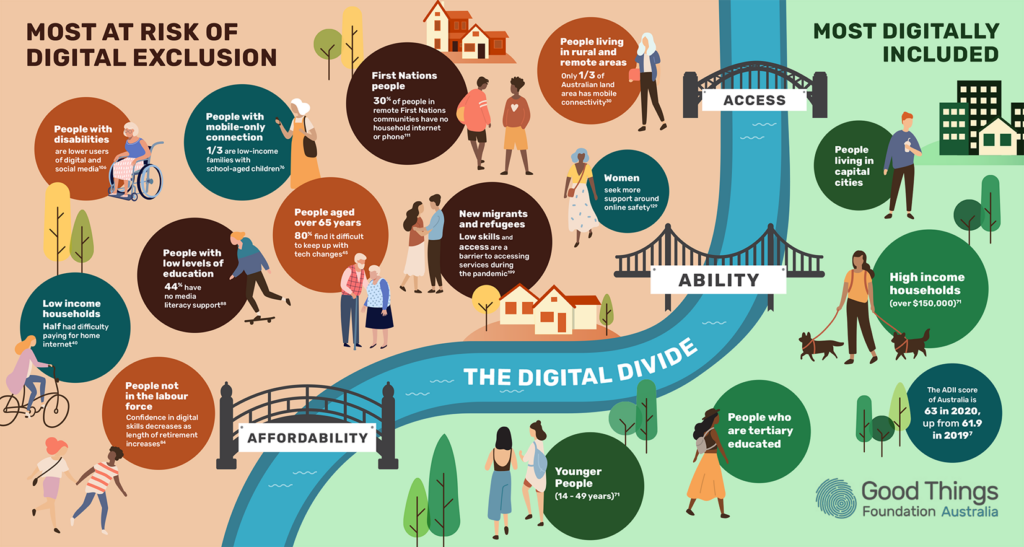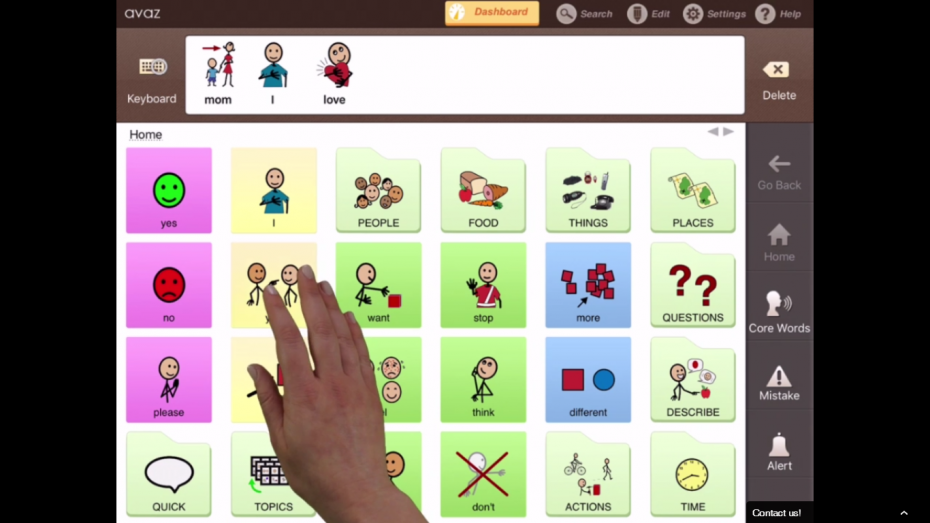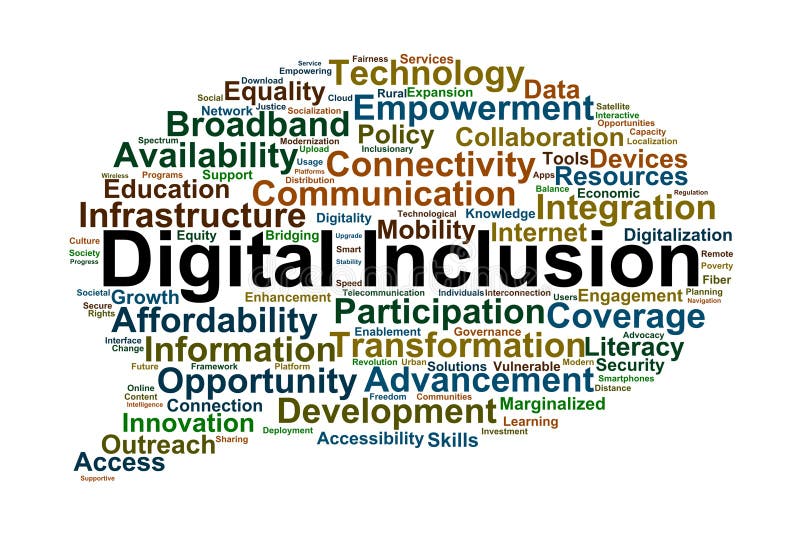After listening to the agree side video during the debate “technology has led to a more equitable society”, my immediate reaction was to strongly agree with it and take it at face value. After all, every aspect of modern life incorporates or at least involves the usage of digital tools in some form. I reflect on my own experiences in which the educational, health, occupational, and even activist pathways that I have taken are all enabled through technology, and the statement seems to make complete sense. However, as I continued to dwell on this, I find myself stopping at the important questions of “equitable for whom” and “equitable in what ways?”.
On the one hand, I can attest to technology opening up doors that have previously been closed. In my work, I have encountered students who have been labelled as low or non-performers in a traditional learning context excel once they have been provided with the appropriate assistive technology tools to support their learning. This was not miraculous but one of access, as tools such as speech to text technologies and adaptive technology provided a far more equitable experience for these learners in an academic setting. At those times when I can see my students succeed, I can completely buy in to the role of assistive technology  and the tremendous potential it has for all learners who may have previously fallen through the cracks.
and the tremendous potential it has for all learners who may have previously fallen through the cracks.
On the other hand, I consider learners who may not have basic internet access at home. The pandemic highlighted how deep the digital divide runs and how prevalent it is even in the most well funded communities. I recall a survey statistic that over three quarters of teachers in high-poverty schools reported their students could not access the internet to participate in synchronous learning consistently. It is difficult for me to consider a piece of technology or digital tool to be a great equalizer when access is not something that has been equitably extended to all. I recall an interesting RAND study on the digital divide that was conducted at the beginning of the pandemic. The issue for learners and families was not solely about the one-time support of having or not having a digital device, but the ongoing, long-term support, infrastructure, and digital skills necessary for all learners.
It is this inconsistency and dichotomy that frustrates me the most. It is not just the devices and infrastructure alone but the opportunity that it unlocks. In an ideal world, the internet represents a world of endless possibility in which you can do everything from buy essential goods to taking an online university degree to finding potential work, but it is also the world in which the work is not done, or there is not the support for, a large percentage of the global population. I have not found this to be reconciled or changed in any way, which frustrates me as this is an opportunity gap as well. I came across a recent statistic in an article that I found chilling: “2.7 billion people in the world remain offline, of which 84% of those offline are in the Global South.” (Digital Trends 2023). In an increasingly technological and digital world, I find it upsetting that we are failing so many.
Equally, in the same way, technology does provide that space of opportunity where those who have been traditionally disenfranchised can make their voices heard and not wait for traditional pathways of justice or representation. One story that I find heartwarming in this regard is in the recent case of Florida students using social media platforms to support one another after school shootings occurred and rejecting the “usual” narratives being touted by adults around them. They did not need to wait for an external party to represent their views, as they used digital tools to not only share information and resources with one another but build a movement of civic action.I will qualify some of my own excitement on this, however, as I think the truth is that for every high-profile case of using digital technology to achieve what are otherwise lofty goals, there are countless untold stories of the innumerable individuals, usually from already marginalized communities, who have been either left behind, left out, or directly harmed as a result of systems that have not been designed with their needs and access in mind. Yes, these technologies can help us see areas of bias, discrimination, and social injustice in an unadulterated format that previously would not have been visible, but they can also be just as adept at replicating those same issues in a new guise if we are not cautious in our approach. As much as I have read about the potentials of artificial intelligence to drastically improve access to healthcare, clean water, sanitation, education and reduce global inequality (Pappas, 2023), I know anecdotally and in other literature that without ethical design and rollout, these tools will benefit only a privileged few.
I don’t believe that I am changing my position on the original statement by the conclusion of this exercise, but rather refining it. Technology can lead to a more equitable society, but it is not guaranteed or automatic and takes hard work and effort. It does not just happen organically through increased distribution. Equity is not built into the device or the technology but in the design, the necessary systems of support and, more importantly, the desire to make things more inclusive. We have to be as deliberate and intentional about access as we are about innovation.
 As such, it is less of an either-or answer but more of a consideration that while I reflect on my own experiences in which technology has helped many, I need to be cognizant that for every student, family, or individual who benefits, there are likely many more who are still struggling. This reflection is not a rejection of technology but a call to always remember whom we are building these tools for and not to conflate access and connectivity with equality.
As such, it is less of an either-or answer but more of a consideration that while I reflect on my own experiences in which technology has helped many, I need to be cognizant that for every student, family, or individual who benefits, there are likely many more who are still struggling. This reflection is not a rejection of technology but a call to always remember whom we are building these tools for and not to conflate access and connectivity with equality.
Nofisat, I found your post really interesting and I liked how you explained your points about technology and equality in education. You made it clear that just adding devices or online tools doesn’t make things fair for everyone. I agree with you that students’ backgrounds, home resources, and level of support from teachers or parents make a big difference in how much technology can actually help.
I also liked the way you pointed out that access to technology alone is not the solution. Even in schools where everyone has a device, some students still struggle to use it effectively while others move ahead quickly. This shows that the gap is not just about having the tools, but also about guidance and support in how to use them.
I think schools could create extra small group sessions or workshops to help students who have less experience with technology. This way, those students can catch up in a safe and supportive environment, and the gap between students might not grow bigger.
But as of now equity is in question.
Kritika
Thank you, Kritika! I really appreciate your thoughtful response. You’re absolutely right access is just one part of the equation, and without proper guidance, the gap can even widen. I love your idea of small group sessions or tech workshops truly creating those safe learning spaces could really empower students who need more support. Thanks again for engaging with my post!
Hi Nofisat,
I was like you originally and took the debate statement “at face value” for many of the same reasons. If we look around it is really easy to see how technology has led to more equity. I think of students I have had who are non-verbal but are not able to communicate using assistive technologies, or healthcare people can access online, and all my friends who live in rural areas who now see therapists via online platforms. But your question, “equitable for whom?” entered my mind throughout the debate. The answer to this was easy for me, it’s equitable for those who have access, and access requires a certain amount of privilege. It is leaving out the people who do not have the privilege of access to technology. In order for us to say technology has made for a more equitable society, we have to be able to say that for all parts of it. Thanks for your well-rounded reflection. I enjoyed how you captured both sides of the debate and reflected deeply on your own position.
Thank you so much for your kind words and I really value the perspective you’ve shared here.
Hi Nofisat,
Thank you for your fantastic post! You very clearly articulated many of the thoughts that I had during the debate and you elaborated on a few ideas that really stuck out to me. We can’t blame the technology – it is the application, intentionality, support and infrastructure that all needs to be considered with technology. On a very small scale, if you look at an Elementary school, you will find some teachers embracing technology and using it with their students to enhance learning, some teachers who only use the technology for games and videos and still other teachers who avoid using technology at all. All the teachers have access to the same technology but because the exposure, training, and ongoing support are lacking, the students have varying experiences.
I loved your call to action at the end of you post: “to always remember whom we are building these tools for and not to conflate access and connectivity with equality.”
Thanks again for a great post and for being a great partner during our debate!!
It was such a honor working with you Carol. Have a wonderful holiday. I hope you enjoy your trip.